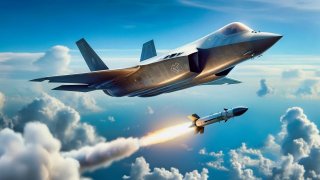China's J-35 Fighter Could Be a Terror Flying from an Aircraft Carrier
Summary: The Shenyang Aircraft Corporation (SAC) has advanced China's naval aviation with the J-35, a fifth-generation fighter that enhances the People’s Liberation Army Navy's (PLAN) capabilities.

-The J-35, resembling America's F-35 but lacking VTOL capabilities, requires a catapult for takeoff.
-While tested on older carriers like the Liaoning, the J-35 is set to fully integrate with the new Type 003 Fujian, which features advanced electromagnetic catapults.
-Initially using Russian RD-93 engines, China is now developing the indigenous WS-13E engine.
-With robust missile-carrying capacities, the J-35 significantly boosts China's naval strength, challenging U.S. dominance in blue-water naval operations.
J-35 Fighter: China's Answer to U.S. Naval Aviation Superiority
The Shenyang Aircraft Corporation (SAC) of China may have pushed their military aviation capabilities two generations from beyond where most Chinese war planners had believed their aircraft carrier-based warplanes would be.
The J-35 fifth-generation warplane has been around in some iteration since 2011.
But it is only just now becoming a key player in China’s People’s Liberation Army Navy (PLAN), which is currently on a shipbuilding spree—specifically an aircraft carrier-building spree—that has already upset the once-favorable balance of naval forces between the United States and China. The J-35 just might be the clincher for the PLAN becoming a true Blue-Water Navy.
J-35: China’s Answer to the F-35
The J-35 is considered to be China’s answer to America’s F-35 Lightning II warplane. The J-35 is China’s other fifth-generation warplane (the more well-known Chinese fifth-generation warplane is the Chengdu J-20 “Mighty Dragon,” which is more analogous to the Air Force’s F-22A Raptor). Unlike the American F-35, China’s J-35 lacks the vertical, takeoff, and landing (VTOL) capability that the F-35s possess. The VTOL feature comes in handy for F-35 warplanes operating aboard aircraft carriers.

China’s J-35 being a conventional take-off-and-landing warbird requires a catapult to push it forward on takeoff from an aircraft carrier deck. Although, it should be noted that the Chinese placed a J-35 aboard their original aircraft carrier, the Liaoning. The Liaoning, like its sister carrier, the Shandong, lacks a catapult for takeoff.
Instead, these older carriers utilize a ski jump for their airwing to use when taking off. The Chinese may have been testing the J-35 aboard the Liaoning to see if it was possible to deploy a J-35 as part of an airwing of either the Liaoning or the Shandong.
But the next-generation Chinese carrier, the indigenously built Type 003—the Fujian—possesses electromagnetic catapults of the same kind that America’s newest breed of aircraft carrier, the Gerald R. Ford-class possesses. In fact, most experts believe that the Fujian’s electromagnetic catapult was a cloned version of the US electromagnetic catapult that is on the USS Gerald R. Ford (because Chinese espionage artists stole the designs for the next-generation catapult).
The J-35 prototypes used Russian-built RD-93 engines. But, in typical Chinese fashion, the Chinese military does not want to remain reliant on any outsider for anything…especially their national security.
Features of the J-35
So, China encouraged its defense sector to develop a new engine for China’s newest warplanes. This, despite the awful track record that China’s indigenous engines have. The Chinese are feverishly developing an indigenous engine for their warplanes, the WS-13E. This engine produces 22,000 pounds of thrust.
This bird can carry four missiles in its main compartment as well as having six external hardpoints capable of carrying 13,000 pounds of munitions. The jet’s main weapons run the gamut from the PL-10 short-range missile to PL-12 medium-range air-to-air missile. In other words, this system is not to be trifled with.
The J-35 is a serious addition to China’s growing arsenal of highly dangerous systems.
About the Author
Brandon J. Weichert, a National Interest national security analyst, is a former Congressional staffer and geopolitical analyst who is a contributor at The Washington Times, the Asia Times, and The-Pipeline. He is the author of Winning Space: How America Remains a Superpower, Biohacked: China’s Race to Control Life, and The Shadow War: Iran’s Quest for Supremacy. His next book, A Disaster of Our Own Making: How the West Lost Ukraine, is due October 22 from Encounter Books. Weichert can be followed via Twitter @WeTheBrandon.
All images are screenshots/Chinese Internet.


